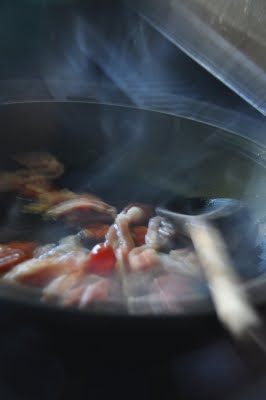The weather is wet, windy and cold and not particularly conducive to heading up Munros, so our thoughts turned to hill walks past and we thought we would document a few particularly memorable walks from our big trip in 2007.
First up is Dougga in Tunisia. Having started our trip in Morocco we then headed east stopping next at Tunisia. We spent some time in Tunis visiting Carthage and spending hours and hours in the Bardo Museum admiring the amazing mosaics, before taking a day trip out of town, travelling about 80km to Dougga.
The archaeological site of Dougga is located in the North-west region of Tunisia, perched on the summit of a hill at an altitude of 571 m, dominating the valley of Oued Khalled. The site covers an area of approximately 75 ha and is an astonishingly intact Roman city, complete with 21 temples. It is considered the best-preserved Roman town in North Africa. The ruins of a complete city with all its components form a testimony to more than 17 centuries of history. They are an outstanding example illustrating the synthesis between different cultures: Numidian, Punic, Hellenistic, and Roman. Early authors such as Diodorus Siculus, writing at the end of the 4th century BC note that Dougga was a city of 'fine size'.
We had a fabulous day when we visited, sunny and the views were just stunning. We also befriended a number of donkeys which always makes for a good day!

Remains of a ruined theatre at Dougga. The theatre was built in 168 AD and is one of the best preseved examples in North Africa. It could seat 3500 spectators, even though Dougga only had 5000 inhabitants, which was pretty ambitious by anyone's standards!
A dedication engraved into the pediment of the stage of the theatre and on the portico that dominates the city, recalls the building’s commissioner, P. Marcius Quadratus, who 'built [it] for his homeland with his own denarii', (Roman currency), the dedication was celebrated with 'scenic representations, distributions of life, a festival and athletic games'.

The theatre is still used for performances of classic theatre, particularly during the festival of Dougga.... however when we visited there was hardly another soul to be seen.

The city as it exists today consists essentially of remains from the Roman era dating for the most part to the 2nd and 3rd century AD. The Roman builders had to take account both of the site’s particularly craggy terrain and of earlier constructions, which led them to abandon the normal layout of Roman settlements and use their imaginations. The site really has everything even some dolmens but we didn't seem to manage to photograph them.
A local and his donkey!
More donkey stalking....

Finally caught up with a small one. Some friends in Morocco had taught us the words for various animals in arabic. We drew pictures and they wrote the arabic and laughed at us trying to pronounce them correctly! Here's Donkey - حمار (Hmar).

An overgrown courtyard with a beautiful array of wild flowers.

The capitol is a Roman temple principally dedicated to Rome’s protective triad: Jupiter, Juno & Minerva. It has a secondary dedication to the wellbeing of the emperors Lucius Verus and Marcus Aurelius; therefore the capitol must have been completed in 166-167. Although it is pretty weathered, the pediment bears a depiction of emperor Antoninus Pius’s elevation to godhood. The emperor is being carried by an eagle.
The building in which we were standing to take this pic is called the Dar Lacheb. Through the doorway you can see the capitol. The purpose of the edifice known as Dar Lacheb (the house of Lacheb) has not been clearly identified, although it was probably a temple.
The winding paved streets.
One of the most significant monuments in Dougga is the Lybico-Punic mausoleum in the southern part of the town. This is the only major monument of Punic architecture still surviving in Tunisia. This tomb is 21 metres tall and was built in the 2nd century BC. It was reconstructed in 1908-10.

Ruins amongst Dougga’s olive trees.
One of the inscriptions at Dougga. I haven't yet been able to find out why it has been left as a circle -but it's pretty cool. So if you're in Tunisia visit Dougga it's amazing....
 ....The notebook.....bear in mind this was done in the back of a car..... it seems like deer might have stumped our hosts!
....The notebook.....bear in mind this was done in the back of a car..... it seems like deer might have stumped our hosts!
 ....The notebook.....bear in mind this was done in the back of a car..... it seems like deer might have stumped our hosts!
....The notebook.....bear in mind this was done in the back of a car..... it seems like deer might have stumped our hosts!












































